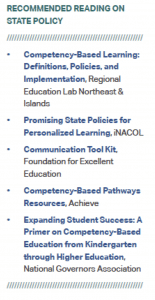The Every Student Succeeds Act: A Catalyst for Competency Education at Scale?
CompetencyWorks Blog

This essay by Susan Patrick and Maria Worthen was featured in the report Reaching the Tipping Point: Insights on Advancing Competency Education in New England.
New England’s competency education journey is the story of how stakeholders, coming together to create a shared vision for student success, can move the needle on state – and ultimately federal – policy.
When the Every Student Succeeds Act (ESSA) passed in December 2015, it reflected the lessons learned and the advocacy of educators, superintendents, state leaders, and congressional representatives from New England to make room for systems that align to competency-based education. Congressional staff looked to states like New Hampshire to ensure that they could continue to implement innovative performance assessments for accountability purposes that also support learning.
The new flexibilities in ESSA did not appear out of thin air. They are the result of years of hard work by states who are getting results from competency-based education, but were unable to fully realize their vision due to the limitations of No Child Left Behind (NCLB). The New England states featured in Beyond the Tipping Point: Insights in Advancing Competency Education in New England are well-positioned to take advantage of ESSA’s opportunities to deepen their efforts in shifting to personalized, competency-based education.
What Are ESSA’s Opportunities for States?
 ESSA, the new K-12 federal education law, shifts significant power back to states, with increased flexibility to rethink accountability, redesign systems of assessments, and modernize educator development. It provides a new opportunity for states to redefine what success means for students, beyond a single test score, and to align systems around this vision. It is now possible to design a more student-centered education system in which assessment supports learning and accountability enables data-rich, continuously-improving personalized learning environments in which students advance upon mastery. In this new era, states also have the opportunity to shape the future of the teacher workforce, building the capacity to take on the new roles required in a competency-based system.
ESSA, the new K-12 federal education law, shifts significant power back to states, with increased flexibility to rethink accountability, redesign systems of assessments, and modernize educator development. It provides a new opportunity for states to redefine what success means for students, beyond a single test score, and to align systems around this vision. It is now possible to design a more student-centered education system in which assessment supports learning and accountability enables data-rich, continuously-improving personalized learning environments in which students advance upon mastery. In this new era, states also have the opportunity to shape the future of the teacher workforce, building the capacity to take on the new roles required in a competency-based system.
Rethinking Accountability
Under ESSA, state accountability systems will now be required to include at least four indicators, providing a historic opportunity for states to rethink the definition of student success. These indicators include:
- Grade-level proficiency;
- English language proficiency;
- Graduation rates; and
- An indicator of school quality selected by the state, which could include student and teacher engagement, school climate, and non-cognitive skills.
States may include any other indicators beyond these four in their accountability system; however, all indicators must be disaggregated by student subgroup, and the first three indicators listed above must carry the greatest weight in identifying schools for improvement. States must identify at least the bottom five percent of the lowest performing schools in the state for comprehensive improvement, and the schools with the greatest achievement gaps for targeted improvement of subgroup performance.
Opportunities to advance competency education under ESSA’s accountability provisions are significant: states could align a set of indicators to their vision of student success, create data dashboards that support educators to drive continuous improvement of student learning in personalized learning environments, and engage students, families, and communities with transparent data on students’ progress toward success. States could also prioritize personalized, competency-based school models for school improvement.
Redesigning Systems of Assessments

States can now design their systems of assessments to engage students and teachers with valuable information that supports learning in real time and produces summative information for accountability purposes.
ESSA, as in the past, maintains the requirement to assess students annually in grades 3 through 8 and once in high school in Reading/English Language Arts and Math, and disaggregate the results by each student subgroup. However, while NCLB relied on a single, end of year test, ESSA allows states to use multiple assessments to produce annual determinations of student success. This will provide richer, more meaningful data about where students are in their learning, and better understanding of subgroup achievement gaps.
Additionally, all states now have significant new flexibility to design systems of assessments that align with and support personalized, competency-based learning, including:
- Growth measures that track individual student progress;
- Adaptive assessments that may include items outside of students’ grade levels, which would provide valuable information to pinpoint where students actually are in their learning progressions;
- Multiple assessments that are administered over the course of a year, so long as they can be combined into a single summarize rating. This makes room for interim assessments that students could take when they are ready to demonstrate mastery, and multiple types of academic measures that provide a more complete picture of student learning; and,
- Performance assessments and other types of assessments that allow students to demonstrate mastery of academic standards. These types of assessments are more deeply connected to learning, providing a positive experience for students and allowing demonstration of transfer of skills and deeper knowledge.
Together, these flexibilities liberate states to fully align their systems of assessments to competency-based education.
The New England states are in different places when it comes to their approaches to assessment, but a unifying vision for competency-based learning is a strength that they all share. Starting with this as a core value will ensure that states can build next generation systems of assessments that support teaching and learning.
Innovative Accountability and Assessment Demonstration Authority
As New Hampshire’s experience shows, creating high-quality innovative systems of assessments takes significant planning, stakeholder collaboration, and investments in teacher capacity to develop and score common performance tasks with fidelity. For states wishing to pilot innovative systems of assessments in a subset of districts, there is an Innovative Accountability and Assessment Demonstration Authority in ESSA that will initially allow up to seven states to participate. The pilot requires the innovative assessments to meet a high bar for technical quality and to demonstrate comparable results to the statewide assessment. States must have a plan to go to scale to all districts and ensure demographic representation statewide during the pilot phase. After five years, the Secretary of Education may grant permission to a state to permanently transition to the innovative systems of assessments.
Building the Foundation for Competency Education – Investing in Teacher and Leader Capacity
There are no “silver bullets” in education policy, and ESSA is no exception. This new federal law provides long-awaited flexibilities that make innovation for equity possible. However, the ability of innovative new systems of assessments and next generation accountability to improve learning for all students hinges on the capacity of educators to make it work.
Efforts to transform education to student-centered learning must start with teachers and local districts. ESSA opens up a window of opportunity to engage stakeholders in redefining what it means to be an effective educator with the new skills required for personalized, competency-based learning. By doing away with NCLB’s “highly qualified teacher” requirement, which based teacher quality determinations on degrees, not competency, states can begin to rethink licensure requirements, teacher preparation, and professional development around a new definition of effectiveness. Micro credentials would allow pre-service candidates and teachers to demonstrate mastery of discrete teaching competencies and to “stack” them towards licensure, certification, and deepening their practice through professional development to advance along career pathways.
Leaders and educators in the New England states hold valuable insights into the needed investments in teacher capacity and development. The lessons they have learned could benefit other states embarking on their own journey to competency education.
Engaging Communities to Scale and Sustain Competency Education
Many of the states profiled in this paper are well positioned to leverage ESSA’s flexibilities to support student-centered learning at scale. They can build on a culture of education that values competency-based education to build next generation systems that empower students, educators, families, and communities.
Community engagement is a crucial ingredient for successful implementation and sustained results – when stakeholders feel that their perspectives are considered in the development of new systems, they will become active participants who feel invested in their success.
In Implementing Competency Education in K–12 Systems: Insights from Local Leaders, Chris Sturgis recounts the process that education leaders in Pittsfield, New Hampshire used to engage their community:
- Start with questions, not solutions;
- Structure governance to include community and students;
- Inform design and implementation from multiple perspectives; and
- Reach out into the community.
This provides a helpful framework for each stage of the planning process states will go through to implement ESSA, starting with the question: “What does success look like for our students?” and continuing throughout implementation to sustain buy-in and create a feedback loop.
Conclusion
For states on a similar trajectory, New England states’ stories could provide a roadmap for developing ESSA plans that build capacity for competency-based education. However, context matters, and what works in New England may not work in other parts of the country. New England has regional characteristics, including small states with close geographic proximity, strong intra-state networks, and an intermediary, which may have led to the sharing of practiced across state lines.
It is interesting to reflect on what it would take to see another regional center for competency education developing. For example, a number of western states are beginning to pass legislation to move away from seat time and support mastery-based learning. Perhaps ESSA will be the catalyst for a new wave of states to make the shift to student-centered learning.
Learn More:
- Report: Reaching the Tipping Point: Insights on Advancing Competency Education in New England
- Report: Promising State Policies for Personalized Learning
- Blog: 9 Ways States Can Support Personalized, Competency-Based Education Systems
- Blog: From Compliance to Continuous Improvement: Accountability, Assessments and Next Generation Workforce Under ESSA
- Blog: Systems of Assessments that Support Student-Centered Learning and Continuous Improvement